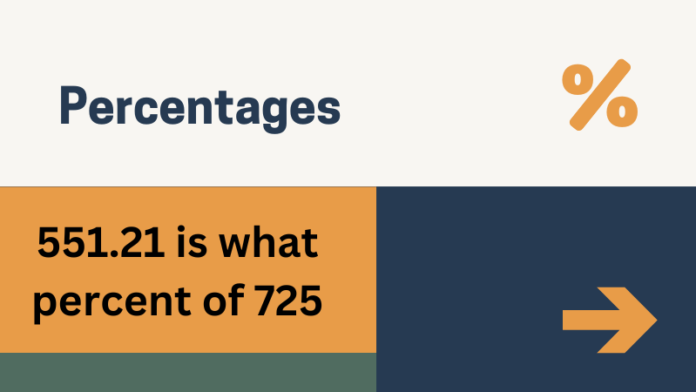Percentages are an essential part of everyday life, whether you’re calculating tips at a restaurant, understanding discounts while shopping, or making financial decisions. But percentages can seem confusing when you don’t know where to start. In this guide, we’ll show you just how simple it can be to calculate percentages, focusing on the specific example: What percent is 551.21 of 725?
What is a Percentage?
Percentages are everywhere—on price tags (30% off!), interest rates, and even nutrition labels. Understanding percentages helps you make better decisions and interpret important information quickly.
The Formula for Finding Percentages
The formula to find what percentage one number is of another is simple:
Percentage=(PartWhole)×100\text{Percentage} = \left( \frac{\text{Part}}{\text{Whole}} \right) \times 100
Where:
- The Part is the number you’re trying to find the percentage for (in our case, 551.21).
- The Whole is the total or maximum value (in this case, 725).
This formula works for any percentage calculation you need to make!
Applying the Formula to Our Example
Now let’s calculate what percent 551.21 is of 725 using the formula:
Percentage=(551.21725)×100\text{Percentage} = \left( \frac{551.21}{725} \right) \times 100
By following the formula step by step, we’ll break it down.
Breaking Down the Calculation
Step 1: Divide 551.21 by 725
First, divide the part (551.21) by the whole (725):
551.21725≈0.7607\frac{551.21}{725} \approx 0.7607
Step 2: Multiply by 100
Now, multiply the result by 100 to convert it into a percentage:
0.7607×100=76.07%0.7607 \times 100 = 76.07\%
So, 551.21 is 76.07% of 725.
Interpreting the Result
What does this percentage mean in real-world terms? It means that 551.21 represents 76.07% of the total value, 725. For example, if 725 were the total budget for a project, and you spent 551.21, you would have spent 76.07% of your budget.
Why Knowing Percentages is Important
Percentages help you compare parts of a whole. Whether you’re figuring out how much of a discount you’re getting or how much of your monthly budget you’ve already spent, percentages give you a clearer understanding of proportions.
Examples from Everyday Life
- Shopping Discounts: Knowing how to calculate percentages helps you figure out the savings during sales. If something is 30% off, you can quickly know how much you’ll save and what the final price will be.
- Finance: Whether it’s understanding interest rates on loans or calculating returns on investments, percentages are a cornerstone of personal finance.
- Data Interpretation: In statistics and data reports, percentages help you grasp trends and proportions quickly.
Other Examples of Percent Calculations
Let’s look at a few more examples of percentage problems:
- What percent is 300 of 500?
(300500)×100=60%\left( \frac{300}{500} \right) \times 100 = 60\%
- What percent is 150 of 1000?
(1501000)×100=15%\left( \frac{150}{1000} \right) \times 100 = 15\%
These examples follow the same formula we used earlier.
Common Mistakes to Avoid
- Misunderstanding the Formula: Many people mistakenly switch the part and whole, leading to incorrect results.
- Calculator Errors: Sometimes, errors happen when entering numbers into a calculator, so always double-check.
Practical Tips for Calculating Percentages Easily
- Use a Calculator: If you’re dealing with large numbers or need an exact answer, a calculator is your best friend.
- Mental Math Tricks: For quick estimates, round numbers and use shortcuts. For example, finding 10% is as easy as moving the decimal one place to the left.
Percentage in Business and Finance
In business, percentages help track growth, understand profit margins, and calculate interest rates. For example, a bank may offer an interest rate of 5%, which means your investment grows by 5% each year.
Percentages in Statistics and Data
In research and data analysis, percentages help communicate results clearly. For example, if 80% of survey participants preferred one product over another, that percentage makes it easy to visualize the data.
Learning Tools and Resources
There are plenty of resources to help improve your percentage calculation skills:
- Apps: Tools like “Percentage Calculator” or “EZ Percent” make calculations easy.
- Websites: Websites like Khan Academy offer detailed lessons on percentage calculations.
- Books: “Basic Math & Pre-Algebra for Dummies” is a great resource to deepen your understanding.
Conclusion
Percentages may seem tricky at first, but with a simple formula and a little practice, you can calculate them easily. Whether you’re figuring out what 551.21 is as a percentage of 725 or tackling more complex problems, mastering percentages will give you valuable skills for both everyday life and more advanced tasks.
FAQs
- How do you convert a number into a percentage?
Divide the part by the whole and multiply by 100. - Why are percentages important in real life?
They help in understanding proportions, comparing values, and making decisions based on data. - Can percentages be over 100%?
Yes, percentages can exceed 100% when the part is larger than the whole. - What is a quick way to calculate percentages without a calculator?
Use mental math shortcuts, such as finding 10% by moving the decimal. - How can I use percentages in everyday decision-making?
From calculating discounts to budgeting, percentages help you make informed financial choices.


